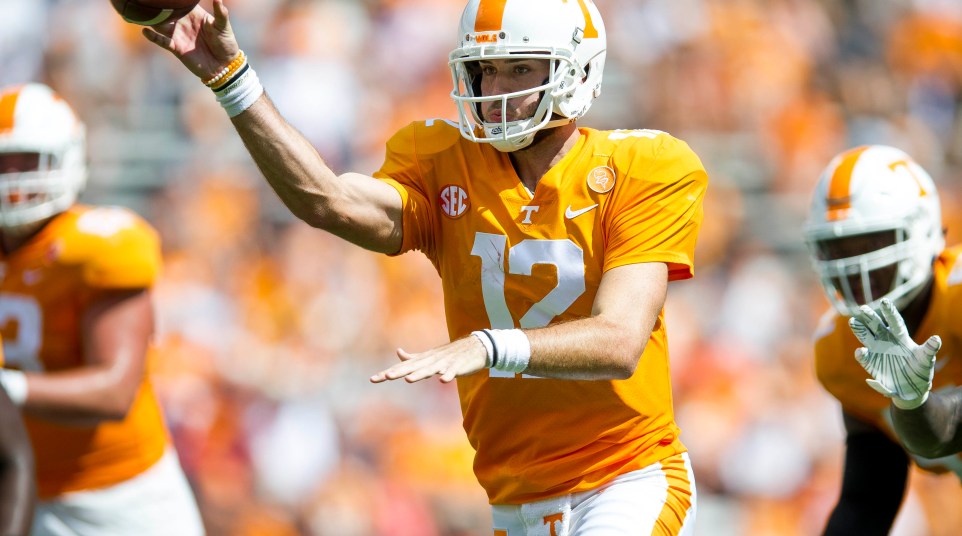
What's up with Tennessee's slumping offense? Film study reveals some basic, troubling flaws
Tennessee’s offense is almost entirely keyed by John Kelly, an ultra-elusive running back who is averaging 5.6 yards per carry and is also only 23 yards behind Tennessee’s leading receiver Brandon Johnson. The Vols managed 442 total yards against Florida — 237 came from handing off to Kelly or throwing him a short pass.
Yet despite having this star runner at the center of their offense, the Vols barely scraped by UMass with a 17-13 victory and now have to face a Georgia defense that might be the best in the division if not the country.
In the wake of these struggles, the Tennessee coaching staff has mostly responded by rotating linemen up front and thus essentially allowing their big men to bear the blame for their middling offensive performances.
Here are a few other issues though that have limited the Vols’ ability to build a better offense around a transcendent talent at running back.
A non-explosive passing game
Quarterback Quinten Dormady is averaging 7.12 yards per pass, but if you throw out the stats from Tennessee’s victory over FCS lightweight Indiana State, he’s averaging 6.5 yards per attempt with four TD passes and three INTs. Remove the numbers he’s stockpiled from throwing quick dumps to Kelly and those numbers get much worse.
Considering how lethal Kelly is on simple handoffs, it would seem that the biggest issue with the Tennessee offense is how non-lethal its passing game is. Considering that it took Butch Jones until this offseason to even hire a QB coach, it would seem that the Vols head coach tends to evaluate the play of his offense almost solely on how well they play up front.
Part of the issue is the lack of effective plays that build off the threat of the run game. Here’s an example of an RPO (run/pass option) attempt against Florida that fell flat:
There are several concerning things here. One is the bubble route taken by the slot receiver, which is much deeper and wider than you normally see on what’s supposed to be a quick hitting play that punishes an aggressive overhang defender.
Another is that the overhang defender you’d want to punish here (nickel Duke Dawson, No. 7) isn’t playing the run aggressively here.
Finally, if you were throwing the bubble off a read you’d normally pull the ball and make the toss much earlier, but instead Dormady fakes the handoff first and doesn’t even look at the defender you’d normally read on this play. This probably isn’t an option read but a pre-determined throw.
A real RPO game could give Dormady more easy reads and throws that could result in big yardage beyond screen passes to Kelly, but the Vols don’t seem to have one.
Their normal passing game isn’t much better. Here’s an example in which they tried to run double slants (perhaps their favorite passing play) on the goal line against the Gators:
The Gators are double teaming that first slant, but the second slot receiver fails to win inside on his slant and so Dormady is just throwing it straight to the defender (Dawson again). When opponents clamp down on Tennessee’s favorite route combinations, things can get very ugly in a hurry.
Predictable formations
You wouldn’t guess it from Kelly’s big statistical day, but Tennessee struggled to run the ball on the Gators’ fantastic DL and aggressive linebackers. They had similar issues a week later against UMass. The solution they settled on that nearly (should have) won the day against Florida was running inside zone from double TE formations.
When teams block straight up with two TEs, that creates several new gaps that the defense can only account for by trusting DBs to handle those TE blocks on the perimeter or to fill interior creases as they open up.
In the latter event you risk getting plowed on the perimeter while in the former you end up in scenarios where the safety has to make a tackle on Kelly with some space to play in.
The only problem is that if Tennessee is relying on double TE formations to run the ball effectively, it makes the Vols even more predictable than they already are.
Tennessee’s offense is essentially about execution of key concepts; they don’t try to trick people or get particularly exotic or creative, they just want to out-execute opponents with superior play up front and get the ball to playmakers like Kelly.
But when the vast majority of snaps from this set …

… end up as runs (and too often the inside zone concept shown above) and then a vasty majority of snaps from this set …

… prove to be passes (and too often the double slants concept shown above), then you make life hard on your own players to consistently out-execute their opponents.
Offense always relies on the fact that they know where they are going and where the ball is likely to go before the play starts, while the defense has to figure those things out and then get moving. Tennessee regularly strips itself of that advantage with predictable formations.
While Joshua Dobbs has moved on, Tennessee still has a foundational player at the center of its offense in Kelly who could make life easier for the rest of their offense.
If only they could find ways to relieve pressure by allowing game theory to inspire their passing game and play call sheet.




